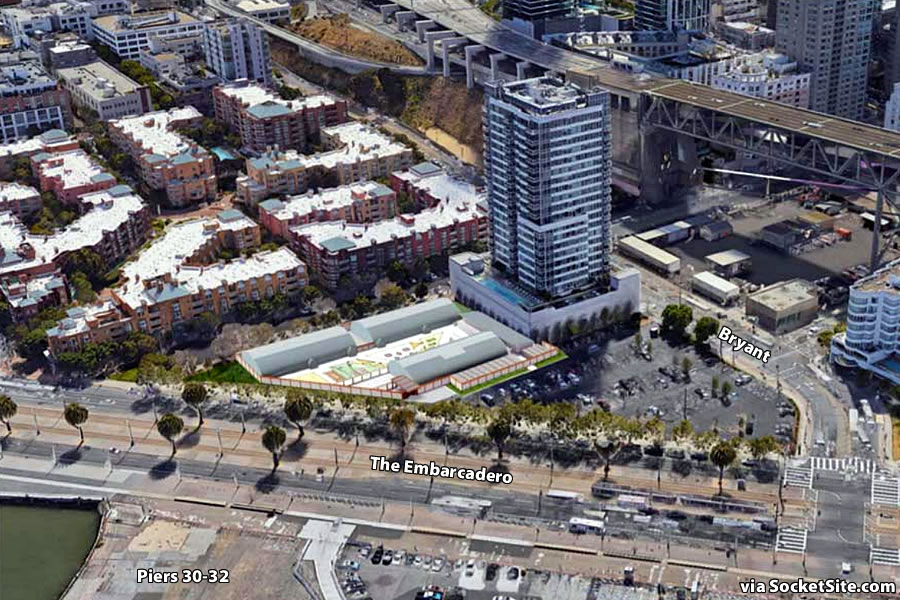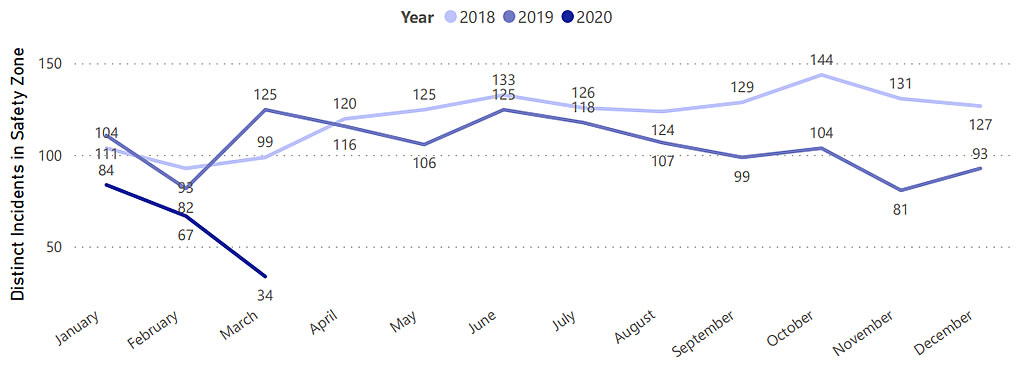With three full months of data in hand, the central argument of the group which had vocally opposed the opening of the Embarcadeo Navigation Center upon the Port’s parking lot parcel known as Seawall Lot 330, adjacent to the Watermark and across from Piers 30-32, has been rendered moot, at least to date.
And in fact, in conjunction with an overall drop in reported incidents citywide, the crime rate in the designated “safety zone” around the Embarcadero Navigation Center site has dropped sharply since the center opened at the end of last year.


This data is as meaningless as NYC going 58 days without a pedestrian death. You can’t do YoY comparisons for these things when no one is going outside.
While the particularly sharp drop in March was certainly aided by San Francisco’s stay-at-home order which was issued in mid-month, reported incidences were trending down in January and February as well. And of course, in terms of places people have still been going outside since the stay-at-home order was issued, the Embarcadero has attracted attention for how busy it has remained.
Reported incidences also appeared to be trending down since June of 2019, so it could also be explained by a preexisting trend. That aside, two data points is a pretty terrible source for conclusions of any kind. I think it was a good move though to put the navigation center there though.
Or as we noted last year, “the crime rate in the “safety area” around the Embarcadero Navigation Center site has actually been on the decline, particularly since the center…broke ground in July.”
And while a couple months of data is far from ideal, the first quarter trend was still down, not up, while the number of reported crimes citywide was effectively even on a year-over-year basis in January, February and early March.
I don’t think “meaningless” as much as “needs to be viewed with caution” (note that even in prior years the data sometimes moved in opposite directions). Posting similar data from other districts would allow for a useful comparison (hint, hint)
So true – though there is foot traffic along the Embarcadero, it’s well below pre-COVID levels. There has also been significant police presence (squad car and bicycle) which has never been the case in the last 20 years except during special events. I would not attribute crime drop to the nav center itself.
I don’t think the issue is showing that the Nav Center was causal in lowering crime, and claiming that it would cause crime to go down would have been sketchy at best. The fact that crime hasn’t gone up (even after factoring in COVID) is a pretty damning indictment of the NIMBY insistence that it’d cause crime to skyrocket in the area.
Um, crime isn’t quarantining for covid.
Crime is down city-wide Ken
Honestly, even if crime increased this would be a worthwhile project. Just because you’re rich doesn’t mean that you should get to be insulated from the homelessness that the rest of us deal with all the time.
Funding drug addiction and despair all over the city, for billions of dollars is “worth” it ? Because that is the actual result of 30 years of “supportive” policies. No matter how much has been done or spent, the vagrant deluge increases.
Funding drug addiction? Do you understand how these programs work?
Tough criminalization and cold turkey drug abatement are ridiculously outdated and ineffective notions.
Even if Clyde was not espousing “tough criminalization and cold turkey drug abatement” (and it’s not clear he is), he can still object to Navigation Centers, on the grounds that they don’t do enough to discourage or curtail drug use by those homeless people whose addiction is the cause of or perpetuating their homelessness.
Unlike many shelters operated by traditional charities, navigation centers are expressly designed to offer “a low threshold for entry”. What that means for practical purposes is that homeless addicts do not have to be sober or drug-free to enter a Navigation Center and once enrolled, they can come and go at will. So some addicts smoke or inject themselves off-site and then return to the Navigation Center while they are high or to rest between drug use episodes.
This phenomenon tends to reduce public support among neighbors of Navigation Center clients for policies and services to help the homeless to a level somewhat lower than it would be if homeless addicts were guided toward long-term sobriety.
“Long term sobriety” is a tough goal, though. What do we do with people who are not able to or willing to meet that goal? Isn’t one goal for the Navigation Center “harm reduction”?-and arguably having them inside and fed is harm reduction-even for the neighbors who would otherwise have to step over them?
Anecdotally, as someone who lives & works nearby, and walks directly by this site to the Embarcadero about once a week, I used to see multiple homeless folks in the small plazas/parking lots around Bayside Village every single time. I haven’t noticed any people in crisis there in a few months.
That’s funny – I saw a group of 8 – 10 near the Bayside Market yesterday.
Well, that shouldn’t be surprising to you. Since the beginning of the new coronavirus outbreak The S.F. Board of Supervisors passed an ordinance to secure 7,000 hotel rooms for homeless people who were then on the street. So far, San Francisco has placed 965 homeless people in hotel rooms at no charge, and has signed contracts for 2,731 rooms for homeless people and essential workers.
The solution to crime is navigation centers! Let’s put another one next to this and it’ll drop even further! Let’s turn 850 Bryant into a navigation center!
so there should be no objection to putting one in every neighborhood now.
Sorry but this is the kind of gaslighting of the public that has ruined (along with corruption of which much emanates from the real estate developer crowd) any semblance of Trust in the media or leadership in SF. Most crime down by the bay was tourists being preyed upon. No tourists equals a drop in crime. Meanwhile I took a periodic stroll (scroll to be more accurate) down 311 lane the other day doing screen shots of the 50% or more of 311 public complaints about crime, filth, health and safety threats and drug dealing/abuse with photos of sprawling out of control tent camps all over the eastern side of SF. And of course the Hub scam with its hideous piles of view-blocking buildings is getting approved while the public is unable to turn out and protest… Good times!
By far the most insidious and pervasive corruption in SF is that which is demonstrated by housing-secure NIMBY homeowners (aided and abetted by an assortment of “useful-idiot-type” renters and so-called “neighborhood activists”), who — by their “rent seeking” behavior — hijack the political process to stymie adequate housing creation and thereby create a chronic housing shortage resulting in skyrocketing housing costs.
Now that’s real corruption!
P.S. BTW, did you build the home you live in or did the so-called “real estate developer crowd” do it for you?
How do you define “corruption”?
One persons “terrorist” is anothers “freedom fighter”.
I typically think of corruption as behind-the-scenes payoffs or manipulation of the process that would not come about otherwise. Not quite sure how democatic pressure by those affected equates to “corruption” by those applying inappropriate pressure who inordinately stand to benefit.
That is something that always amuses me about NIMBY’s. They all work in their careers for free (no profit-seeking capitalists them) and they built their Pioneer American log cabins with the timber hewed from their homesteads themselves! Dammit, I feel a song coming on! An epic song!
and in other news residential water consumption is up by 10%
How does this compare to city wide trends? It seems like, given the circumstances, viewing this in a vacuum is relatively meaningless. If this has fallen more than city wide crime, then it would point towards something out unique regionally. If it’s fallen less than city wide trends, it seems like the finger could be pointed towards the Navigation Center (or some other local factor). And if it’s just the same as city wide, it seems like it’s probably just a city wide phenomenon overshadowing the center.
I usually support Socketsite but this is 100% bullshit reporting. I’m sorry. The Nav center has been a bad idea since it’s inception by every metric, regardless of how much crime it has increased (or has become “moot” as this article (mis-)states. ) When 85+% of the clients leave on their own or are kicked out, and a tiny percent (less than 5%) receive some sort of housing placement (albeit likely temporary but there isn’t any followup data yet) — there is no way you can call this “experiment” successful. Do we all need to accept we can all help out somehow? Yes, but this solution was a bad one.
SocketSite should publish property values in that neighborhood since the navigation center went live. Whether you like them or not, I would imagine they are a big disincentive for anyone thinking about buying in that area.
Of course, Property values have nothing to do with the overall residential price declines (chronicled in this very site) over the past year or so. Exacerbated by COVID and the coming Great Depression II, Homeless Booggaloo.